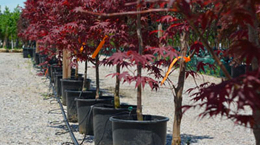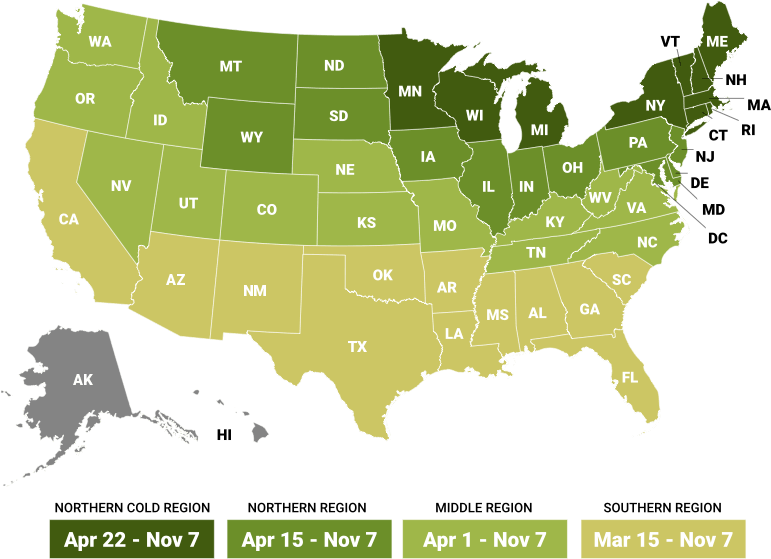
Growing zones
See Zone Map >Status: In stock
- Sun, Part Sun/Shade
Mature Plant Size (H x W): 2-3' x 2-3'
Bloom Season: Summer, Fall
- Attracts Bees
- Deer Resistant
- Drought Tolerant
- Salt Tolerant
- Long Blooming
- Award Winning
- Stone Mulch
- Attracts Butterflies
- Fragrant Flowers
- Fragrant Leaves
- Attracts Pollinators
Planting & Care for Walker's Low Catmint Perennials
Preparation
- Walker's Low catmint plants grow in open, sunny areas but tolerate partial shade.
Its aromatic foliage will be most fragrant if planted on a site with full sun. - Grows best in garden growing zones containing fertile sandy loams.
- They are low-growing perennials reaching 1-3 feet in height.
- Catmint can be planted in March-June, September, or October.
- Hardy plant that can withstand minimum winter temperatures of up to 4 degrees Fahrenheit.
- Plant near vegetables to deter flea beetles. The scent is also said to deter rats.
Members of the mint family require a lot of water, so keep this plant moist at all times. Do not stand plants in water, as this can drown them. - Mulch lightly in spring and fall, and give a balanced general fertilizer in early to late spring.
- Feed it nitrogen-rich fertilizer, such as poultry manure, in spring for more leaf growth.
Opening Plant Material
- Containers: Completely saturate all container plants by putting them in a larger water container until bubbling stops. Remove the plant, then dig a hole no deeper than the depth of the container, ensuring it’s wider on the sides by an additional 6” or more.
Planting Containers
- Catmint can be planted in March-June, September, or October.
- Dig a hole no deeper than the depth of the container and 6" or wider on the sides.
Slide the plant from the pot by tapping on the bottom of the pot. - With a shovel or knife, trim the bottom 2" off the root ball for plants in plastic containers.
- Rotate the plant to the proper position. Never lift or move plants by the tops.
Place the root ball in the hole. - Adjust the plant height so the root crown is slightly higher than the ground.
- Notice where the base of the trunk flares out from the tree. This is called the root flare. This root flare should show when the tree is planted. If necessary, add soil under the ball so the root flare is exposed.
- Place fertilizer packets into the bottom of the hole (if purchased). *Use Our Recommended Fertilizer.
- Backfill the hole with soil, ensuring the top of the root ball is visible and slightly higher than the soil around it.
- Firm the soil around the plant. Water well to settle soil around the root ball.
Pruning - After Planting
- Containers: Although it’s not essential after planting, light pruning can help shape a Walker’s Low catmint. Doing so removes any broken branches from shipping or thins out a heavily branched plant to assist in the transplanting process and the appearance of your new planting.
Pruning - Through-out the Season
- Prune catmint during or after flowering to encourage new growth and possibly a second round of flowers.
- When it flowers in the spring and early summer, individually prune spent flowers to the ground or cut the entire plant back by one-half to two-thirds after it has finished flowering. Discard the trimmings.
Watering - After Planting
- Plants typically take approximately 6 weeks to establish new roots in your soil. During this period, water plants as often as every 2-4 days at the start and at least a minimum of once per week.
- Beyond the 6-week establishment period, water once per week unless rain occurs.
- Remember to check soil moisture by sticking your finger into the soil around 3”.
Watering - Through-out the Season
- After the first season, plants should only be watered during extended periods without rain.
- How do you know if your plants need water? The easiest way to tell is to touch the soil around the roots. If it is moist, there is no need to water. If it’s dry, give it a good soak with the hose end (no nozzle), watering the soil only, not the leaves.
- Same as after planting, stick your finger into the soil around 3” to check soil moisture.
Frequently Asked Questions
What are the common pests and diseases that affect Walker's Low catmint?
Walker's Low catmint is relatively resistant to many pests and diseases, making it an ideal choice for gardeners. However, it can occasionally be susceptible to spider mites and aphids, especially in dry, hot conditions. Fungal diseases like powdery mildew can also appear in humid climates. Regular monitoring and maintaining proper air circulation around the plants can help minimize these issues.
How can I encourage more blooms in Walker's Low catmint?
Deadheading is a key technique to encourage more deep lavender-blue flowers to bloom. It involves removing the spent flowers before they set seed. This practice tidies up the plant and redirects its energy towards producing new blooms rather than seeds. Regular deadheading throughout the blooming season can help extend the flowering period and promote denser, more vibrant growth. Additionally, ensuring the plant gets enough sunlight and is planted in well-draining soil will further enhance its blooming potential.
Can Walker's Low catmint be used in companion planting?
Walker's Low catmint is excellent for companion planting because it attracts beneficial insects and repels pests. It pairs well with other drought-tolerant perennials like Echinacea and Rudbeckia, also available at McKay Nursery. These combinations can help create a vibrant, low-maintenance garden that thrives throughout the growing season.
How long does Walker's Low catmint bloom?
Walker's low catmint offers a long blooming season, typically starting early- to mid-summer and extending through fall, especially if deadheaded regularly. This extended bloom period makes it an excellent choice for adding consistent color and texture to garden beds and borders.
Can Walker's Low catmint be grown in containers?
Yes, Walker's Low catmint can thrive in containers, making it a versatile choice for patios, balconies, and other areas with limited space. Ensure the container has good drainage holes and use a high-quality potting mix. Container-grown catmint may require more frequent watering and a little extra fertilization to compensate for the restricted growing environment.
Enhance Your Garden With McKay Nursery
Elevate your landscape design with McKay Nursery's expertise, honed for more than a century in the horticulture industry. From our scenic location in Waterloo, Wisconsin, we specialize in cultivating hardy and vibrant plants, including the eye-catching walker's low catmint. When you choose McKay Nursery for your gardening needs, you're assured of top-quality plants supported by our one-year warranty.
Order your own Walker’s Low catmint now, and get ready to beautify your landscaping. For expert advice or additional support, contact us at [email protected] or call 920-478-2121.
Planting & Handling Help
Download our Planting and Handling Guide below to plan for a successful arrival and install of your plants. Be sure to water all plants as soon as they arrive and every day until you’re ready to plant. Keep any bare root bundles in a shady, cool spot with the roots covered at all times.


Learn More
Watch our videos on handling bare root plants, how your order is prepared for shipment and more.


Plant Sizing
What is the difference between Containers, Grow Bags, Bare Root, and Balled & Burlap (B&B)?
Shipping Times


Our FedEx and local shipping times depend on two factors, one is by the region and the second is the type of product being shipped. For example, small fruits are only shipped in spring, but majority of our perennials are shipped from spring until fall. Keep in mind the dates below act as a general guide. Due to unpredictable weather, staffing, inventory and industry demands these timelines can change. Therefore, we cannot guarantee any of these times.
Shipping Dates by Region*
Northern Cold Region: April 22nd - November 7th
Northern Region: April 15th - November 7th
Middle Region: April 1st - November 7th
Southern Region: March 15th - November 7th
Local Delivery (small radius from Waterloo, WI): April 22nd - November 7th
Shipping Dates by Season*
Spring Shipping: Region Start Date (above) - May
Fall Shipping: September - November
Due to unpredictable weather, these times may vary. Some varieties are exceptions due to heat and plant health reasons. Enter your shipping zip code at the top of this page and be sure to check the shipping information on each product before you add it to your cart. If the product is too large or restricted in your state, you will not be able to checkout with that item in your cart.
